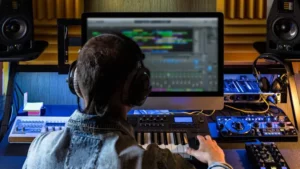Written by Jeevan T Joy , Music Programmer & Arranger, Keyboardist
Music production encompasses a wide range of processes involved in creating a song or background score, including composing, arranging, recording, mixing, and mastering. However, the approach to these processes can vary depending on the genre of music. Each genre has its own distinct characteristics, instrumentation, and production techniques that contribute to its unique sound. Let us have a glimpse on how to approach the music production for each genres in Music
What are genres in music?
Genres in music refer to categorisations or classifications that are used to distinguish and group music based on shared characteristics, styles, or cultural origins. Genres provide a way to organize and classify the vast variety of musical expressions and help listeners identify and explore the types of music they enjoy. Here are some commonly recognized genres & music production methods
Pop music production is known for its catchy melodies and polished sound. It typically features a tight and well-produced arrangement that aims for broad appeal. The production process focuses on creating a clean and attractive sound, often with a simple song structure that is easy to follow.Key elements used in pop music production include vocals, drums, bass, synthesizers, and various electronic instruments. The combination of acoustic and electronic elements is common in pop songs, as it provides a balance between organic and synthesized sounds. The production techniques employed in pop music aim to create a full and impactful sonic experience, utilizing techniques such as layering, effects, and precise mixing
Hip-hop music production is deeply rooted in the African-American community and is known for its rhythmic speech or rap delivery over beats. It often incorporates elements of sampling, where existing audio recordings are used to create new musical compositions.Drum programming, sequencing, and sampling are key components of hip-hop music production. Drum beats play a central role in driving the rhythm and energy of the track. They are often created using drum machines or software, allowing producers to craft unique and dynamic patterns. Sampling involves taking snippets or loops from pre-recorded songs and manipulating them to create new musical elements within a hip-hop track.In addition to drums and sampling, hip-hop production may include other instruments such as basslines, synthesizers, and various sound effects. Producers often experiment with different sounds and textures to create a distinct sonic landscape for the music.Hip-hop music production is known for its creativity and innovation, with producers constantly pushing the boundaries of what is possible. The genre has evolved over time, incorporating new technologies and production techniques, while still retaining its core elements of rhythm, rap, and sampling.
R&B (Rhythm and Blues) is a genre that emerged from a combination of jazz, gospel, and blues influences. It is characterized by soulful vocals and strong rhythm sections. R&B and soul production aims to create a warm and intimate sound, focusing on capturing the emotional depth of the music.In R&B and soul production, a blend of live instrumentation and electronic elements is often used. Instruments such as pianos, guitars, and horns contribute to the rich and dynamic sound of the genre. These live instruments are complemented by electronic instruments, adding a modern touch to the production.Vocal performance is a key aspect of R&B and soul music. Producers pay careful attention to capturing the nuances of the vocalist’s performance, often using techniques like vocal layering to create lush harmonies. Effects such as reverb and delay are used strategically to enhance the vocals and add depth to the sound.Intricate arrangements are also a hallmark of R&B and soul production. Producers carefully structure the instrumentation, paying attention to the placement and interaction of different musical elements. This attention to detail ensures that each instrument and vocal part contributes to the overall texture and groove of the song.Overall, R&B and soul production focuses on creating a captivating and soul-stirring listening experience. The genre’s blend of live instrumentation, electronic elements, rich harmonies, and intricate arrangements sets the stage for heartfelt performances and memorable musical moments.
Rock music is a diverse genre encompassing various subgenres, each with its own distinctive style. It is characterized by the prominent use of electric guitars, strong rhythms, and energetic performances. Rock music production aims to capture the raw and powerful essence of the genre.In rock music production, guitars play a central role. Electric guitars are often used to create the signature riffs and melodies that define the genre. Acoustic drums provide a solid foundation, driving the rhythm and adding intensity to the music. Bass guitar adds depth and groove to the overall sound.The goal of rock production is to capture the energy and live feel of the performance. Producers work to create a balance between the instruments, ensuring each element contributes to the overall sonic impact. Vocals play a crucial role in rock music, delivering powerful and emotive performances that convey the lyrical message.Effects play a significant role in shaping the tone and dynamics of rock music. Distortion is commonly used to add grit and aggression to the guitar sound. Reverb is employed to create a sense of space and depth. Compression helps control the dynamics and ensure a consistent and impactful sound.Rock music production is characterized by its emphasis on capturing the authenticity and intensity of the performances. The genre allows for experimentation and creativity, with producers exploring different sonic possibilities to create a unique and powerful listening experience.
Orchestral & Classical music is a genre deeply rooted in Western art music traditions. It is known for its rich and complex compositions performed by a large ensemble of instruments, typically referred to as an orchestra.Orchestral music production revolves around a wide range of instruments, including violins, violas, cellos, double basses, harps, timpani, horns, and drums, among others. These instruments are carefully arranged and played together to create a harmonious and symphonic sound.Orchestral music is often performed by a group of musicians, as the genre relies on the collective sound and dynamic interaction between the instruments. In its more intimate form, quartets are composed of violins, viola, and cello, with each instrument played by a single musician.Orchestral music is highly valued by film music composers, as it provides a grand and expansive sound that enhances storytelling and emotional impact. The arrangement of orchestral music requires meticulous attention to detail and precise placement of harmonies to achieve the desired sonic effect.The production process for orchestral music involves working with skilled musicians, capturing their performances through recording techniques, and utilizing professional mixing and mastering to achieve a balanced and immersive sound. The goal is to create a sonic experience that captures the richness and grandeur of the orchestral compositions, allowing listeners to appreciate the intricate layers of instrumentation and the emotional depth of the music.
Indeed, music production is a creative and dynamic process, and artists often push the boundaries of genres to create unique and innovative sounds. While the examples mentioned earlier provide an overview of some popular genres and their production approaches, it’s important to note that the possibilities are endless.Moreover, advancements in technology have opened up a world of possibilities for music production, allowing artists to explore new sounds, effects, and production methods. With digital tools, virtual instruments, and computer-based production software, artists have greater flexibility and control over the creative process.
Ultimately, music production is about expressing creativity, capturing emotions, and delivering a captivating listening experience. Whether it’s staying true to the conventions of a specific genre or breaking new ground with innovative approaches, the beauty of music production lies in the freedom to explore and create something truly unique and impactful. Do share your thoughts in the comments section.
